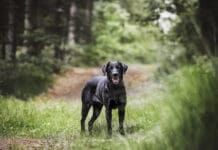All dogs instinctively know how to stretch and do so with great enjoyment. Dogs stretch without fail upon awakening and whenever the mood strikes during the rest of the day. Who hasn’t watched a dog inch his front paws out in front of him as far as possible leaning into the stretch until it literally ripples along the length of his trunk? When the stretch finally reaches the hips, the hind legs are extended far behind the body in what appears to be total ecstasy. The dog completes the routine by dropping to his elbows and stretching the back in a doggy bow that temporarily elevates the rump. Then, the hindquarters flop to the floor in a grand finale to the stretch.
Since dogs seem to have their own very efficient and obviously satisfying stretch routine, why should we stretch them?
A stretch is a relaxing move that reduces muscle tension and stiffness, improves circulation of blood and lymph, and increases flexibility and range of motion. These benefits reduce the risk of injury and can help in the rehabilitative process following injury or surgery. (But remember: Always ask your veterinarian for approval before massaging or stretching an injured dog, or one that has recently had surgery.)
In this article, we will consider two types of stretches that can benefit your dog. Passive stretches require you to do the work, while active stretches have the dog do the work with your guidance.
All stretches, passive and active, should be done after the dog’s muscles are warmed up and circulation is increased. A massage, romp, or short walk are perfect ways to prepare your dog. Stretching should always be done gently, with caution, and within the anatomical limitations of the joint.
-By C. Sue Furman
Author Sue Furman is an Associate Professor in the Department of Anatomy and Neurobiology at Colorado State University in Ft. Collins, CO. In addition to her academic career, she is active as a free-lance writer and teaches equine and canine massage classes. This article is adapted from material in her new book, Canine Massage, that will be available in spring 2000.





